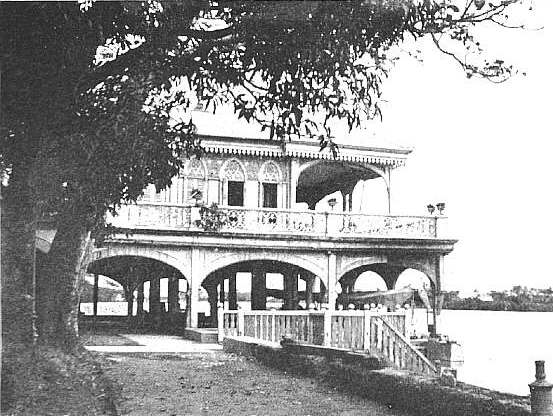Fabulous Philippines > Manila > Malacanang Palace, Manila
Malacanang Palace
Manila
Share this page:
The historical Malacanang Palace (Spanish, Palacio del Malacanang) – often referred to just as Malacanang -- is the official residence of the President of the Philippines.
It is located on the bank of the Pasig River in the Manila suburb of San Miguel.
History
Malacanang Palace was originally built in 1750 by a Spanish nobleman, Don Luis Rocha, as a summer house.
In 1825 it was purchased by the Spanish Government and it then became the summer residence of the Governor General of the Philippines.
In those months when the heat in their official residence, the Palacio del Gobernador (Spanish, Governor’s Palace), located inside the walled city of Intramuros a few kilometers away from Malacanang Palace, became stifling, the Governors General were able to move temporarily to Malacanang and enjoy the breezes and fresh air of the latter building, situated as it was on the Pasig River and surrounded by gardens.
When the Palacio del Gobernado collapsed in the earthquake of 3 June 1863, the Spanish Government decided not to rebuild the Palacio del Gobernador and that from now on the Malacanang Palace would be the official residence of the Governor General of the Philippines.

Malacanang Palace and Pasig River, Manila in 1898
When the Philippines came under the control of the United States in 1898, the Malacanang Palace became the residence of the U. S. Military Governors (beginning with General Wesley Merritt) and from 1901 of the U. S. civilian Governors General (the first being William Howard Taft).
Over the years Malacanang Palace was home to 18 Spanish governors general and 14 American civil governors.
When the Philippine Commonwealth was established in 1935, Malacanang served as the official residence of the President of the Philippines, the first being President Manuel L. Quezon.
Architectural Aspects
Originally built as a private country house, Malacanang was developed into an ornate Spanish colonial palace of mostly wooden buildings, complete with arches, patios, azoteas (______), balconies, grilles, and sliding windows with panes made of capiz shells.
Under American rule and during the post-Independence period, it was renovated on several occasions including most extensively during the residence (1965-86) of President Ferdinand Marcos.
The Americans renovated Malacanang and enlarged the grounds on which it stood (by purchasing the surrounding estates reclaiming land from the Pasig River). They raised Malacanang’s ground level to prevent flooding during typhoons, gradually replaced wooden structures with concrete, and embellished the interiors with hardwood paneling and chandeliers.
Malacanang survived World War II with minimal damage (mainly to the southern section that had been shelled).
In the period 1978-79 Mrs. Imelda Marcos, then the First Lady of the Philippines, reconstructed and expanded much of the Palace. A Cermonial Hall, Presidential bedroom, a new dining room, and larger guest suites were constructed. A disco was built on the roof level.
The Palace was made bullet-proof and central air-conditioning and its own electricity supply was installed.
Mrs. Marcos' makeover of the Palace was completed by 1 May 1979, the silver wedding anniversary of President and Mrs. Marcos.
With the People Revolution and the subsequent departure of the Marcoses in 1986, the Malacanang Palace was opened to the public as a museum for three years.
Share this page:
Author: David Paul Wagner
(David Paul Wagner on Google+)
|